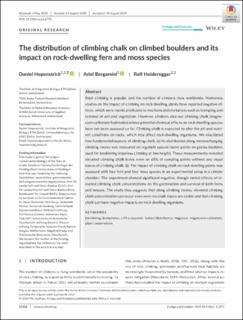Bitte benutzen Sie diese Kennung, um auf die Ressource zu verweisen:
https://doi.org/10.21256/zhaw-21321| Publikationstyp: | Beitrag in wissenschaftlicher Zeitschrift |
| Art der Begutachtung: | Peer review (Publikation) |
| Titel: | The distribution of climbing chalk on climbed boulders and its impact on rock‐dwelling fern and moss species |
| Autor/-in: | Hepenstrick, Daniel Bergamini, Ariel Holderegger, Rolf |
| et. al: | No |
| DOI: | 10.1002/ece3.6773 10.21256/zhaw-21321 |
| Erschienen in: | Ecology and Evolution |
| Band(Heft): | 10 |
| Heft: | 20 |
| Seite(n): | 11362 |
| Seiten bis: | 11371 |
| Erscheinungsdatum: | 1-Okt-2020 |
| Verlag / Hrsg. Institution: | Wiley |
| ISSN: | 2045-7758 |
| Sprache: | Englisch |
| Schlagwörter: | Bouldering; Bryophytes; Cliff ecosystem; Human disturbance; Magnesia; Magnesium carbonate; Plant conservation |
| Fachgebiet (DDC): | 333.7: Landflächen, Naturerholungsgebiete |
| Zusammenfassung: | Rock climbing is popular, and the number of climbers rises worldwide. Numerous studies on the impact of climbing on rock-dwelling plants have reported negative effects, which were mainly attributed to mechanical disturbances such as trampling and removal of soil and vegetation. However, climbers also use climbing chalk (magnesium carbonate hydroxide) whose potential chemical effects on rock-dwelling species have not been assessed so far. Climbing chalk is expected to alter the pH and nutrient conditions on rocks, which may affect rock-dwelling organisms. We elucidated two fundamental aspects of climbing chalk. (a) Its distribution along nonoverhanging climbing routes was measured on regularly spaced raster points on gneiss boulders used for bouldering (ropeless climbing at low height). These measurements revealed elevated climbing chalk levels even on 65% of sampling points without any visual traces of climbing chalk. (b) The impact of climbing chalk on rock-dwelling plants was assessed with four fern and four moss species in an experimental setup in a climate chamber. The experiment showed significant negative, though varied effects of elevated climbing chalk concentrations on the germination and survival of both ferns and mosses. The study thus suggests that along climbing routes, elevated climbing chalk concentration can occur even were no chalk traces are visible and that climbing chalk can have negative impacts on rock-dwelling organisms. |
| URI: | https://digitalcollection.zhaw.ch/handle/11475/21321 |
| Volltext Version: | Publizierte Version |
| Lizenz (gemäss Verlagsvertrag): | CC BY 4.0: Namensnennung 4.0 International |
| Departement: | Life Sciences und Facility Management |
| Organisationseinheit: | Institut für Umwelt und Natürliche Ressourcen (IUNR) |
| Publiziert im Rahmen des ZHAW-Projekts: | Naturschutzbiologie der Findlingsflora |
| Enthalten in den Sammlungen: | Publikationen Life Sciences und Facility Management |
Dateien zu dieser Ressource:
| Datei | Beschreibung | Größe | Format | |
|---|---|---|---|---|
| 2020_Hepenstrick_etal_Distribution-of-climbing-chalk_ece.pdf | 846.91 kB | Adobe PDF |  Öffnen/Anzeigen |
Zur Langanzeige
Hepenstrick, D., Bergamini, A., & Holderegger, R. (2020). The distribution of climbing chalk on climbed boulders and its impact on rock‐dwelling fern and moss species. Ecology and Evolution, 10(20), 11362–11371. https://doi.org/10.1002/ece3.6773
Hepenstrick, D., Bergamini, A. and Holderegger, R. (2020) ‘The distribution of climbing chalk on climbed boulders and its impact on rock‐dwelling fern and moss species’, Ecology and Evolution, 10(20), pp. 11362–11371. Available at: https://doi.org/10.1002/ece3.6773.
D. Hepenstrick, A. Bergamini, and R. Holderegger, “The distribution of climbing chalk on climbed boulders and its impact on rock‐dwelling fern and moss species,” Ecology and Evolution, vol. 10, no. 20, pp. 11362–11371, Oct. 2020, doi: 10.1002/ece3.6773.
HEPENSTRICK, Daniel, Ariel BERGAMINI und Rolf HOLDEREGGER, 2020. The distribution of climbing chalk on climbed boulders and its impact on rock‐dwelling fern and moss species. Ecology and Evolution. 1 Oktober 2020. Bd. 10, Nr. 20, S. 11362–11371. DOI 10.1002/ece3.6773
Hepenstrick, Daniel, Ariel Bergamini, and Rolf Holderegger. 2020. “The Distribution of Climbing Chalk on Climbed Boulders and Its Impact on Rock‐Dwelling Fern and Moss Species.” Ecology and Evolution 10 (20): 11362–71. https://doi.org/10.1002/ece3.6773.
Hepenstrick, Daniel, et al. “The Distribution of Climbing Chalk on Climbed Boulders and Its Impact on Rock‐Dwelling Fern and Moss Species.” Ecology and Evolution, vol. 10, no. 20, Oct. 2020, pp. 11362–71, https://doi.org/10.1002/ece3.6773.
Alle Ressourcen in diesem Repository sind urheberrechtlich geschützt, soweit nicht anderweitig angezeigt.